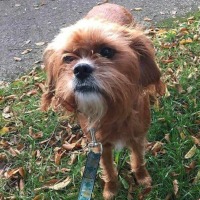Appearance of the Brussalier
|
| The Brussalier is an attractive little Spaniel with a defined muzzle and lower teeth. The head is slightly rounded and domed, with floppy ears that stand out from the head. The body is robust, supporting short legs and small, lightly feathered paws. The Brussalier has large, round, expressive eyes that add to its appeal. The nose has large nostrils and is often black. The coat can vary according to the dominant characteristics of parent breeds. It is longer than the coat of the Griffon Bruxellois, often taking on the plumage of the Cavalier King Charles Spaniel parent. The tail can vary from long, feathered and almost plume-like, to short and curled over the back. Texture leans more towards the silkiness of the Cavalier, but can inherit the harder texture of the Griffon. Regardless of their inherited characteristics, Brussaliers are a winning combination of gentle nature and adorable beauty. |
Temperament of the Brussalier
|
| Brussaliers love attention and are devoted to their owner and family. Although they can be full of their own self-importance, they are also gentle, affectionate and graceful dogs. All dogs vary in nature, and the Brussalier is no different. Some dogs are outgoing and very gregarious, while others are a little more reserved and shy with strangers until they get to know them. While the Brussalier inherits its grace and gentleness from the Cavalier, it can also inherit the willpower of the Griffon Bruxellois and show stubbornness at times. Patient, gentle handling is preferable with these dogs, as they are sensitive by nature and have a gentle spirit. Firm but fair and kind training will benefit your Brussalier, building an obedient and confident pet. They are adaptable to most climates but are affected by extreme heat or cold. They can live peacefully with other dogs and, if introduced early, will happily bond with the family cat. Beware though, they still have a strong urge to hunt and enjoy the chase, so keep an eye on the family bird and if your cat goes after it, the Brussalier will love it. They love to learn tricks, are extremely friendly with children, although if they take after their Griffon parent, they may not be so tolerant. Supervision is advisable at first, and teach young children that such a small dog can be hurt by rough play. |
Needs and activities of the Brussalier
|
| The Brussalier doesn't need much extra exercise, as it's quite active at home. A house with a small fenced-in yard suits these dogs, and they are ideal for apartment living provided they go for daily walks. These dogs are people dogs, and like to be with their human family. The Brussalier will play with other dogs and even cats to which they are accustomed. If they have to be left alone, it's easier if they have company, like a cat friend or another dog, so they feel safe. They do well in most climates, but are not good with extremes. The Brussalier is a real lapdog, loving to be cuddled and happy to sit on your lap while you read or enjoy the TV. |
Maintenance of the Brussalier
|
| The Brussalier is easy to care for, simply brushing 1-2 times a week to maintain its coat, especially if it's the silkier Cavalier type. Bathe if necessary and make sure your dog is completely dry. Look for sores, rashes or signs of infection. A weekly check-up can quickly pinpoint potential health problems. If your dog has feathers on his ears or paws, make sure they don't get tangled. Be gentle when combing out matted hairs, as this could be painful for your dog. Trim the hair on the toes and trim the nails if they become too long. Getting your Brussalier used to having his feet handled early in life will provide a good basis for grooming and health check-ups later on. |









 English (United Kingdom)
English (United Kingdom)